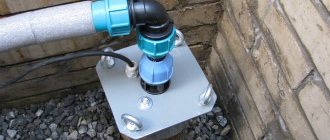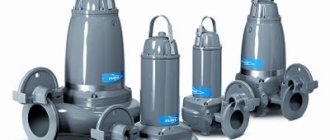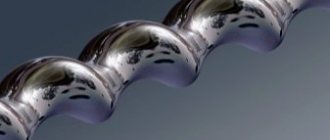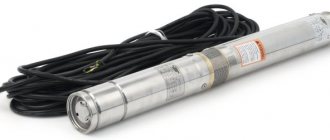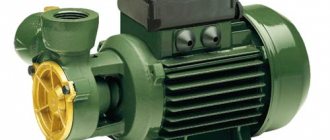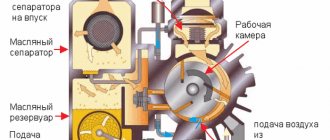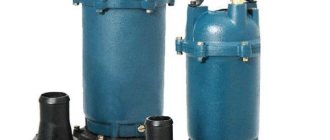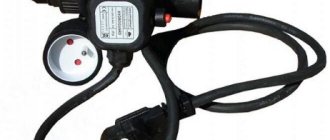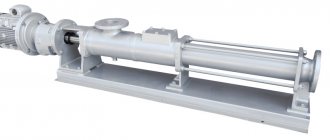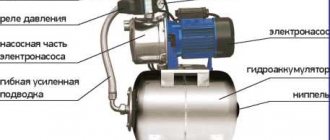Here you will learn:
- Design features of deep-well pumps
- Operating principle of a deep-well pump
- Types of submersible pumps for wells
- Criterias of choice
- Overview of borehole pumps for water supply
- How to bring water from a well into a house with a deep pump
A deep well pump supplies clean water to the surface. The equipment is indispensable in cottage villages and summer cottages. Uninterrupted water supply depends on the quality and correct selection of the pump.
General information
According to their intended purpose, pumps are:
- Deep or borehole. The water must be free of impurities that can damage the mechanism.
- Wells. Unlike deep ones, they have less pressure and are not so long. Small particles of sand or silt are not capable of damaging the mechanism.
- Drainage pumps are designed to work in dirty water. Suitable for a well, pond, basement. Such a pump is capable of passing particles ranging in size from 1 to 7 centimeters.
- Fecal pumps are designed to pump out waste. Be sure to be equipped with a shredder that processes hygiene products.
According to the installation diagram, pumps are either rod or rodless:
- A rod pump is a machine with a motor on the surface. Only the intake part is lowered into the liquid medium.
- The rodless pump is a single unit. Therefore, the engine is immersed together with the intake mechanism in a liquid medium. We must pay tribute to the ease of installation and operation of such pumps.
Operating modes
The new line includes 3 automatic pumps: DTRON, DTRON2, DTRON3 and 1 pump with E.SYBOX DIVER frequency converter. One of the advantages of the devices is 4 different modes of their use:
DRY version , that is, operating mode on the surface, without immersion in water. Yes, that’s right, a submersible pump mounted on a special accessory DOC68 takes water from a tank or from the main water supply, then increases the pressure and pumps it further to consumers. The dust and moisture protection of the pump is IP68, which allows you to safely use it in open spaces.
X – version + KIT X. This version is intended for water in which there are a lot of suspended particles, for example, if the well is made on quicksand, which is quite common. When immersed in water, to prevent the pump from sucking up suspended matter from the bottom, a special hose is installed, at the end of which a float is mounted. This allows you to draw from the surface of the water or from the water column, but high enough from the bottom, thereby supplying clean water without dirt into the system.
Float . A rather interesting engineering solution in which the pump is equipped with remote water level sensors, of which there are two types. The first is a level gauge, which is installed on the pump so that the device can calculate how much water is in the container in which it is installed. To do this, in the mobile application (we’ll talk about this below), the parameters of this capacity are set. The second is a float, which is installed in a container into which the pump supplies water, and according to the readings of this float, the pump, using a control unit, sends a signal to a three-way valve, which switches the water supply either to the container being filled, or to the house, for the water supply system. In fact, one pump works for two systems: water supply to the house and filling a separate container without direct human intervention.
Drinking water mode . This regime is more relevant for European countries where there is separate certification. For our compatriots, it does not have a decisive meaning due to the lack of a standard, but it would be unfair not to mention this.
What determines the cost of a pump?
- The most important thing in the characteristics of a pump is its technical specifications.
The engine is the heart of the pump. The cost directly depends on its type and power.- When the power increases by a difference from 0.75 to 1.5 kW, the cost increases proportionally by 4 thousand rubles.
- The stain resistance feature also affects the price. The higher the stability, the higher the price.
- Performance.
Selection of pumping equipment for a well
Sealed centrifugal pump with shielded motor
When choosing a model, the main parameters will be pressure and flow. Pressure determines the height to which water will be supplied, expressed in meters of water column. Supply is the amount of water that this model can supply.
In order to choose the right centrifugal pump, you need to consider a number of characteristics:
- power;
- noise level;
- water consumption (depends on the needs of the buyer), to supply water to a family of 2-4 people, an option with a capacity of 50-60 l/min is suitable; if you need to water the plants on the site or fill the pool with water, you need to choose a more powerful model;
- water pressure;
- well depth - the maximum height of the water column must exceed the depth by at least 10%.
- the diameter of the casing installed in the drilled well;
- price;
- guarantees;
- the ability to repair the model: availability of necessary spare parts in stores, location of repair shops, etc.
Currently, you can find models on sale from both domestic manufacturers and well-known brands: Makita, Calpeda, Bosch, Wilo, Stiga, etc. The products presented may differ significantly both in price and quality, as well as in technical characteristics, so it is quite possible find a suitable model.
Submersible pump device
Let's take the Aquarius pump as an example. It is easy to use and affordable. It consists directly of a pump and an electric motor. The operating principle is organized using centrifugal force.
Main components of the pump:
- shaft with blades,
- impellers with drive rings.
The parts are held in place by a cap with internal threads. When turned on, the wheels begin to rotate, creating centrifugal force, which, in turn, pumps water.
The motor typically consists of ball bearings, a rotor and a stator.
"Aquarius" is capable of supplying water from a depth of up to 20 meters with a minimum well diameter of 1.2 meters. Using the valve you can adjust the water pressure. The maximum volume of water is 12 cubic meters per hour, provided that the diameter of the hose is greater than 1.9 centimeters.
Design features of deep-well pumps
The design of a deep-well pump and its design features are largely determined by the principle of operation and the type of drive electric motor of this hydraulic machine. When using such pumps, the pumped liquid medium is collected through a special pipe placed in the shaft of the serviced well or in a well. An electric cable placed in a protective sheath is responsible for powering the drive motor, located at a certain depth.
In the design of a centrifugal type well pump, two main parts can be distinguished:
- drive motor, which can be built-in or external;
- directly the pumping part of the equipment.
Design of a centrifugal well pump
If the pump drive motor is built-in, it is usually located at the bottom of the device. Water intake when using pumps of this type can be carried out both through the upper and lower parts of their housing. In this case, preference is given to collecting the pumped liquid through the lower part of the housing, as this allows you to clean the deep part of the well from silt and sand accumulating in it. Submersible pumping devices, which is very convenient, are cooled by the liquid medium in which they are placed. This allows you to protect such devices from overheating, which can quickly render them unusable. Centrifugal-type deep-well pumps, although more complex in design than vibration devices, are characterized by higher reliability, productivity and a longer service life.
The pump suspension must withstand a load exceeding the weight of the pump by 5–10 times
The main design elements of vortex submersible pumps are a housing, a special glass, a drive motor and a vibrator. The vibrator in these devices is the most complex structural element, consisting of an armature, a rubber shock absorber and adjusting washers. The necessary conditions for drawing fluid from a well, carried out by a vibration pump, are created by its rubber shock absorber, which compresses and decompresses during operation of such a device.
A mandatory element of equipping submersible pumping equipment is a coarse filter that protects the inside of such devices from the ingress of solid impurities contained in the pumped medium. To ensure more efficient operation of submersible pumping equipment and ensure its protection from negative factors, various sensors are used that automatically stop the pump when emergency situations arise (the content of silt and sand in the pumped liquid is too high, the water level in the well decreases, etc.).
Connecting the Aquarius pump
We connect the pressure pipe. It can be either plastic or metal or a regular watering hose.- A check valve is required. It is either cut into the pipe at a distance of less than 1 meter from the outlet pipe, or installed directly. A valve with a brass seat works best in this case.
- We attach the cable. As practice shows, lifting and lowering the pump by the wire is not correct.
- We lower the pump into the well and control the tension of the hose and cord.
- We secure the device at the required depth with a cable.
We recommend inspecting the pump for malfunctions every two years.
Types of centrifugal well pumps
Taking into account the location of the shaft, centrifugal pumps are divided into models with horizontal and vertical axes. The cost of models with a horizontal shaft is relatively low, since they are used for water intake from surface and intermediate tanks. Those. where the device can be equipped on the surface, or in a small recess as an equipped shaft, taking into account the sufficient power of the unit.
Water supply needs can be fully satisfied by several methods, however, in the absence of an equipped centralized system, the best solution is to install a centrifugal pump. Models with an integrated vertical shaft are created specifically for the possibility of diving into the well. Such devices are created in several forms:
- The first option involves placing the motor on the surface.
- On the second device, a finished cylinder approximately 10 cm thick is mounted, which is immersed in the working environment along with the motor.
The performance indicator is determined by the number of installed impellers. According to this indicator, well units are divided into 2 groups:
- Single stage.
- Multi-stage.
Single-stage pumps are always more affordable in price, but multi-stage units are designed much more durable, are less likely to fail when impurities enter, and therefore are in much greater demand among consumers.
Several stages can be connected to each other in different ways. If the working chambers are connected to each other in series, the pump produces a pressure increased in accordance with the number of turbines. When the chambers are installed in parallel, the pressure level does not increase. Only the device performance indicator increases.
Pump cleaning and repair
If it is necessary to disassemble the pump, do not forget that the device does not have a filter. A mesh that catches large particles is attached to the outside. You may be able to remove a large clog yourself.
Cleaning is carried out in several stages:
- The protective mesh is removed.
- The cable channel is removed.
- The engine is disconnected from the pump part, then the couplings are removed.
- The disassembled pump is laid horizontally.
- The shaft is turned with a socket wrench.
- Water pressure is supplied, which will remove parts that interfere with the operation of the device.
- We rinse the pump well and reassemble.
Design and principle of operation
Deep-depth apparatus not only have excellent characteristics, but also differ from each other in different designs, which use different operating principles for lifting water.
The entire installation with most of the main parts is under the surface of the water. And from the pump in a dense insulated winding there is a wire and a pipe for supplying water.
A standard equipment assembly usually includes a motor and an internal filter. Liquid suction occurs from below or from above the installation. If the unit has a bottom suction, then it can effectively filter sand and silt from an underwater river.
Deep well pumps consist of two components:
- the pumping part itself with several stages;
- motor, which controls the rise of water and can be either built-in or external.
How to choose the right pump?
Pay attention to the total number of water intake points, the diameter and depth of the well, the geological features of the site, and the presence of network sources.
Important! Select a pump that exceeds the power you need.
So we figured out the design and selection of a submersible pump. Thus, using our recommendations and guided by the information received, you can choose a submersible pump that will suit you perfectly and will last a long time.
Calculation of required functional characteristics
It must be understood that in the process of selecting a suitable pumping installation, many control parameters must be taken into account. The external characteristics of a device may not always matter, but this data should not be neglected either. First of all, you need to determine the appropriate pressure. For this purpose, it is necessary to summarize the sufficient height of rising liquid, as well as the distance from the well to the living space.
To be on the safe side, another 20 meters are added to the resulting coefficient. As a result, you can get a number corresponding to the required pressure indicator pumped by the well pump. You should not worry if you end up with a number of about 50-70 m. This figure is considered the minimum for a conventional borehole centrifugal pump.
The performance of the device must be taken into account. This indicator depends on the number of people living in the house, as well as the planned water consumption. For a family of 3 people and a small garden, it is enough to install a submersible pump that takes about 3 cubic meters of water per hour. This figure will have to be increased if more water needs to be extracted. Pressure and performance level are the main functional characteristics that must be taken into account when selecting centrifugal well units. Other indicators are determined on a residual basis.
Application of centrifugal force
The operating principle of centrifugal pumps.
Pumps, the operation of which is based on the use of centrifugal force to lift water, are widely used in our time. A centrifugal submersible pump for a well pumps water by rotating a special wheel, which is fixed to the shaft.
A little history
The first centrifugal pump, LeDemur's invention.
It is very difficult now to determine who was the first to use centrifugal force to lift water. There are famous sketches made by Leonardo da Vinci. Based on them, it is quite possible to assume that it was he who first proposed pumping water through the use of centrifugal force in a rotating channel.
In practice, the first known device was tested in 1732. It was developed by LeDemur.
The essence of this pump was as follows:
- a pipe was attached to the vertical shaft, rigidly connected to it with a connecting rod;
- the lower end of the pipe was immersed in water;
- the shaft began to rotate, the pipe was also set into rotation;
- centrifugal forces caused water to move in the pipe.
But centrifugal pumps became widespread only at the end of the 19th century. At this time, thermal and then electric engines appeared, which made it possible to create even multi-stage units for deep wells.
The principle of operation of the invention by V.A. Pushechnikov.
Russian engineer V.A. Pushechnikov developed a multistage pump based on the use of centrifugal force for wells up to 250 m deep.
The principle of the device can be described as follows:
- an elastic coupling serves as a connection between the drive shaft and the electric motor;
- the oil bath is located directly under the coupling;
- a ball bearing is placed in the bath, which absorbs the axial load;
- lubricating oil is supplied through a string of pipes suspended from the support frame;
- the column and drive shaft rest on bearings, which are placed in cross-shaped brackets;
- brackets are installed between pipe joints;
- in the support frame itself there is a stuffing box, under it there is a pipe for the discharge pipes;
- The suction fitting of the pump is connected to the suction pipe; there is a safety net on the pipe.
This design makes it easier to place the pump in a well of not very large diameter. The very first pump of this design was manufactured at the end of 1899 and was installed at a water pumping station in Mytishchi.
The tests were successful, and soon 19 such borehole centrifugal pumps were manufactured, which were also installed at this pumping station.
Deep well pumps operating on the basis of the use of centrifugal force.
It is interesting that this order for the production of units was only able to be fulfilled in Paris at the Farco plant, although a proposal to place an order was sent to 24 factories in different countries. In the technical literature you can find the name of this pump as “Farco pump”, and not by the name of the designer.
The principle of operation of modern models
Diagram of a borehole centrifugal pump.
When deciding how to choose a centrifugal pump for a well, you need to understand the main parameters by which the models differ.
Various centrifugal well pumps can be classified as follows:
- according to the number of wheels available, if there is one wheel, then the devices are single-stage, if more, then they are multi-stage;
- by pressure, from low or medium pressure to high values;
- according to the method of water supply, one-way supply or two-way;
- according to the method used to drain liquid into a spiral channel from the impeller, there can be spiral and turbine;
- by speed, low-speed, normal, high-speed.
Important. Despite the fact that the price of multi-stage models is more expensive than single-stage ones, many people prefer to install them. The fact is that such models have a greater safety margin and do not deteriorate due to the presence of various mechanical impurities in the water.
The operating principle of these mechanisms occurs according to the following scheme:
- water is supplied, due to the rapid rotation of the impeller, a plentiful flow is created;
- centrifugal force acts by displacing water from the centers of the wheels to distant areas;
- the pressure inside increases, it displaces liquid into the pipeline;
- the pressure in the center of the impeller decreases accordingly;
- water re-enters through the suction pipe.
The photo shows the appearance of modern centrifugal-type deep-well pumps.
A deep-well pump looks like a cylinder. This allows it to be placed in fairly narrow wells. The length of the structure can be from 0.5 to 2.5 meters, and the diameter is approximately 10 cm. Despite their modest size, these well devices are characterized by excellent performance.
Important. It is necessary to ensure that the pump does not touch the walls of the well alignment during operation. If the diameter of the valve is too small, then it is necessary to protect the unit by placing a rubber ring on its body.
The installation of a centrifugal pump in a well is carried out by specialists, since it is very important to do everything correctly if you want to use water from the well for a long time without any worries.
The unit is lowered into the well to a depth, having previously secured it with a safety cable to the head or cover of the well. The electrical cable is connected to the pump and also passed through a special hole in the head.
The pump must be connected to the pipe with a brass fitting. The second end of this pipe is connected to the outlet on the cover.
If you have experience in installation, you can connect the centrifugal pump to the well yourself. The main thing is to comply with all the requirements described in the instructions for a specific model.
Important. When installing equipment in a well at a depth greater than 80 meters, a pipe is used that can withstand a pressure of 16 atmospheres. For smaller installation depths, it is sufficient to use a pipe of 12.5 atmospheres.
Advantages and disadvantages
Let us list the main advantages of centrifugal pumps:
- High efficiency;
- Reliability in use;
- High pressure-flow properties make it possible to maintain high pressure in the water supply system with a large supply of liquid to the system;
- Possibility to install several working chambers in series or in parallel on one water supply system;
- If the operating mode of the hydraulic system changes, transient processes begin to gradually replace each other;
- The ability to smoothly regulate the power level allows you to start the device when the outlet valve or check valve is closed;
- The pumps can perform a self-priming function;
- Some device models can pump contaminated liquid containing up to 10% impurities;
- A gradual change in the functional characteristics of the device is carried out by changing the voltage in the operating network;
- Possibility of drawing a large volume of water;
- The relatively low cost of the device is ensured by the use of relatively inexpensive materials such as steel, polymers and cast iron in the development.
Disadvantages of centrifugal pumps:
- Surface models must be filled with liquid before starting;
- The phenomenon of cavitation may occur;
- Relatively low efficiency when interacting with viscous liquids;
A significant decrease in efficiency occurs with a small water supply and high pressure.
Criterias of choice
To meet the water supply needs of a particular facility, it is necessary to select equipment based on the following parameters:
- productivity - determines the amount of liquid that the equipment can pump per unit of time. It is necessary to calculate the volume of water consumed when all water intake points are operating simultaneously;
- power - this parameter determines how high the pressure will rise;
- built-in protection - allows you to automatically turn off the pump when the water level in the well is low;
- dimensions - the device must be smaller than the size of the well so that the equipment can be loaded;
- distance to housing - the farther the well is from the water intake points, the greater the pump power needs to be selected.
Our company is the official representative of CPN in Russia. The equipment we sell is industrial and is not intended for home use. Such devices are in demand at large production facilities where high reliability and performance are required.
